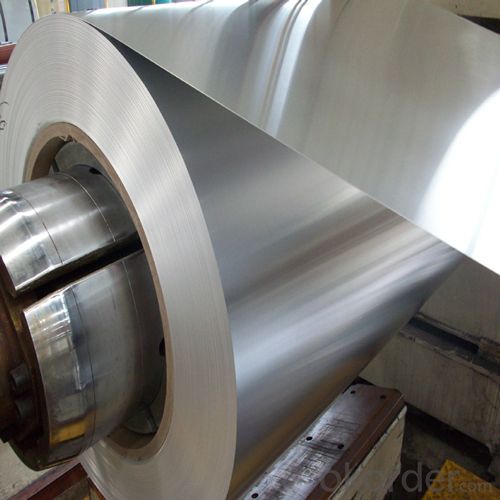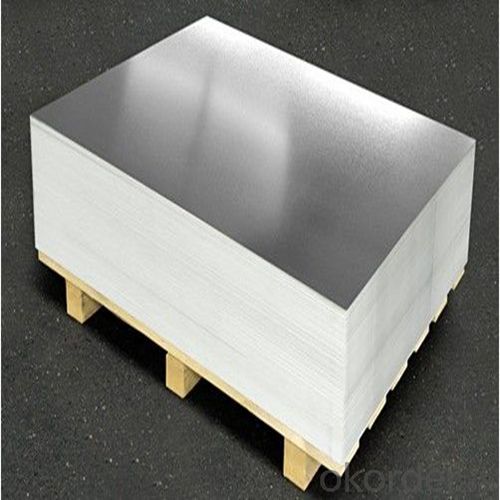Electrolytic Tinplate in Sheets for Cans Packing
- Loading Port:
- Tianjin
- Payment Terms:
- TT OR LC
- Min Order Qty:
- 25 m.t
- Supply Capability:
- 7000 m.t/month
OKorder Service Pledge
OKorder Financial Service
You Might Also Like
1.Structure of Electrolytic Tinplate in Sheets for Cans Packing Description
Electrolytic Tin Plate Coils and Sheets for Foods Metal Packaging, is one thin steel sheet with a coating of tin applied by electrolytic deposition. Tinplate made by this process is essentially a sandwich in which the central core is strip steel. This core is cleaned in a pickling solution and then fed through tanks containing electrolyte, where tin is deposited on both sides. As the strip passes between high-frequency electric induction coils, it is heated so that the tin coating melts and flows to form a lustrous coat.
2.Main Features of the Electrolytic Tinplate in Sheets for Cans Packing
Appearance – Electrolytic Tin Plate is characterized by its beautiful metallic luster. Products with various kinds of surface roughness are produced by selecting the surface finish of the substrate steel sheet.
Paintability and printability – Electrolytic Tin Plates have excellent paintability and printability. Printing is beautifully finished using various lacquers and inks.
Formability and strength – Electrolytic Tin Plates have got very good formability and strength. By selecting a proper temper grade, appropriate formability is obtained for different applications as well as the required strength after forming.
Corrosion resistance – Tinplate has got good corrosion resistance. By selecting a proper coating weight, appropriate corrosion resistance is obtained against container contents. Coated items should meet 24 hour 5 % salt spray requirement.
Solderability and weldability – Electrolytic Tin Plates can be joined both by soldering or welding. These properties of tinplate are used for making various types of cans.
Hygienic – Tin coating provides good and non toxic barrier properties to protect food products from impurities, bacteria, moisture, light and odours.
Safe – Tinplate being low weight and high strength makes food cans easy to ship and transport.
Eco friendly – Tinplate offers 100 % recyclability.
Tin is not good for low temperature applications since it changes structure and loses adhesion when exposed to temperatures below – 40 deg C.
3.Electrolytic Tinplate in Sheets for Cans Packing Images



4.Electrolytic Tinplate in Sheets for Cans Packing Specification
Standard | ISO 11949 -1995, GB/T2520-2000,JIS G3303,ASTM A623, BS EN 10202
|
Material | MR,SPCC |
Thickness | 0.15mm - 0.50mm |
Width | 600mm -1150mm |
Temper | T1-T5 |
Annealing | BA & CA |
Coil Inner Diameter | 508mm |
Weight | 6-10 tons/coil 1~1.7 tons/sheets bundle |
Passivation | 311 |
Oil | DOS |
Surface | Finish,bright,stone,matte,silver |
5.FAQ of Electrolytic Tinplate in Sheets for Cans Packing
- How are the Electrolytic Tin Plates specified?
The Electrolytic Tin Plates are specified as per the steel base, extent of tempering, the coating weight, annealing method and the surface finish.
- How many types there are for base steels?
The base steels are of three types: Type MR, L, D
- Q:Can tinplate be reused?
- Yes, tinplate can be reused.
- Q:How is tinplate formed into different shapes?
- Tinplate is formed into different shapes through a process called cold forming or deep drawing, which involves pressing the tinplate against a die to reshape it into the desired shape.
- Q:What are the main differences between tinplate and tinplate laminates in terms of barrier properties?
- Tinplate is a type of steel coated with a thin layer of tin, while tinplate laminates consist of tinplate combined with other materials such as plastic or paper. In terms of barrier properties, tinplate has a higher level of barrier protection against moisture, oxygen, and light compared to tinplate laminates. This is because tinplate provides a solid and impermeable barrier, whereas laminates may have lower barrier properties due to the presence of other materials. However, tinplate laminates can still offer sufficient barrier properties depending on the specific composition and application.
- Q:What are the main challenges in the disposal of tinplate products?
- The main challenges in the disposal of tinplate products include the need for proper recycling infrastructure, as tinplate is a complex material to separate and recycle. Additionally, ensuring the collection of tinplate products from various sources can be a logistical challenge. Furthermore, the presence of any hazardous materials or coatings on the tinplate can pose environmental risks if not managed properly. Lastly, promoting awareness and educating consumers about the importance of responsibly disposing of tinplate products can also be a challenge.
- Q:What is the purpose of tinplate coating?
- The purpose of tinplate coating is to provide a protective layer of tin on steel or iron surfaces, which helps prevent corrosion and enhance the appearance of the metal.
- Q:Can tinplate be used for electrical applications?
- Yes, tinplate can be used for electrical applications. Tinplate is a type of steel coated with a thin layer of tin, providing it with excellent corrosion resistance and electrical conductivity properties. This makes it suitable for use in various electrical applications such as printed circuit boards, electrical connectors, and electrical enclosures.
- Q:How does tinplate perform in terms of mechanical strength and durability?
- Tinplate exhibits excellent mechanical strength and durability due to its composition of steel coated with a thin layer of tin. This combination enhances its resistance to corrosion, making it long-lasting and capable of withstanding various mechanical forces without compromising its structural integrity. Tinplate is renowned for its ability to retain its shape and withstand impacts, making it a reliable choice for packaging and other applications requiring high durability.
- Q:What are the common surface coatings for tinplate?
- The common surface coatings for tinplate include tin-free steel, electrolytic tinplate, tin-free steel with organic coatings, and tinplate with lacquered coatings.
- Q:What are the common uses of tinplate?
- Tinplate is commonly used in the packaging industry for making cans, containers, and lids for food and beverages. It is also used in the production of aerosol cans, paint cans, and metal closures. Additionally, tinplate is used for making various household items such as kitchen utensils, storage boxes, and tin toys.
- Q:How does tinplate perform in terms of chemical resistance?
- Tinplate performs well in terms of chemical resistance due to its tin coating, which acts as a barrier against corrosion and chemical reactions. This coating provides excellent protection against acidic substances and prevents the metal from being affected by certain chemicals, making tinplate a reliable choice for packaging materials in various industries.
1. Manufacturer Overview |
|
|---|---|
| Location | |
| Year Established | |
| Annual Output Value | |
| Main Markets | |
| Company Certifications | |
2. Manufacturer Certificates |
|
|---|---|
| a) Certification Name | |
| Range | |
| Reference | |
| Validity Period | |
3. Manufacturer Capability |
|
|---|---|
| a)Trade Capacity | |
| Nearest Port | |
| Export Percentage | |
| No.of Employees in Trade Department | |
| Language Spoken: | |
| b)Factory Information | |
| Factory Size: | |
| No. of Production Lines | |
| Contract Manufacturing | |
| Product Price Range | |
Send your message to us
Electrolytic Tinplate in Sheets for Cans Packing
- Loading Port:
- Tianjin
- Payment Terms:
- TT OR LC
- Min Order Qty:
- 25 m.t
- Supply Capability:
- 7000 m.t/month
OKorder Service Pledge
OKorder Financial Service
Similar products
New products
Hot products
Hot Searches
Related keywords




























